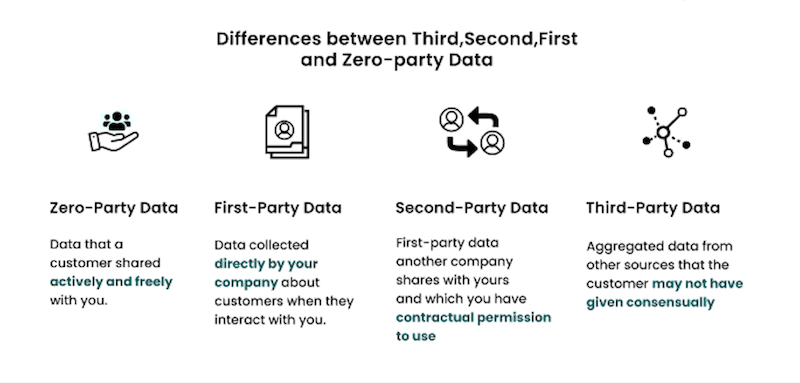Have you ever shopped for something online and then, moments later, found yourself inundated with ads for an eerily similar product? These are third-party cookies (tiny invisible bits of ad-tracking code that record our activity) in action. But the cookie was originally meant to facilitate shopping and browsing. It was not meant to replace first-party customer data or be the basis of an increasingly arcane and intrusive online advertising industry.

It turns out that as much as we appreciate thoughtful personalisation, none of us want to feel as though we are being spied on. We don’t like the uncomfortable sense that someone is tracking our every move. Privacy advocates and regulatory bodies have pushed back against ad tech’s dependence on this kind of surveillance for years. Brands have been trying to walk a fine line: reaching consumers in a relevant way without compromising anyone’s sense of privacy.
Most agree, however, that companies have generally not been very good at maintaining this high-wire act. Now, here we are, with third-party cookies disappearing in 2024. But private companies are acting far sooner than that. Apple announced it would block third-party cookies on its Safari browser. Google announced it would phase them out of Chrome.
“Users are demanding greater privacy – including transparency, choice, and control over how their data is used – and it’s clear the web ecosystem needs to evolve to meet these increasing demands,” wrote Google in its initial announcement of the phaseout.
That web ecosystem now has until late 2024 to evolve, giving developers, marketers, and advertising firms a finite amount of time to answer the question of what comes next.
“The whole infrastructure behind third-party cookies has become unwieldy,” said Marty Kihn Salesforce senior VP. “It’s time for a rethink and a reset. I’m optimistic about what comes next, but the transition period is very uncomfortable.”
First-party data: time for ad tracking and third-party cookie reset
The shift to data-first marketing comes with some potential pitfalls. The first is trying to replace the cookie with another silver-bullet data solution. We don’t believe there will be a single direct replacement for cookies. Some companies are indeed floating various potential alternatives. One of the most widely discussed plans from Google is called Federated Learning of Cohorts (FLoC).
With FLoCs, user data is not sold individually to advertisers but rather in a batch with other users who share similar interests. That way marketers could theoretically target groups of soccer fans, home chefs, or expecting parents without compromising customers’ privacy. Other options include various Universal ID proposals that would allow users to seamlessly opt into tracking at various websites with full consent.
But we’re sceptical. The effectiveness of FLoCs and Universal IDs remains an open question. And we’re not sure these alternatives offer any meaningful privacy benefits compared to cookies. After all, for users to be placed into FLoCs, browsers would still need to track them. We might just be replacing one form of tracking with another.
Let’s say we did find that perfect cookie alternative: We would still be overusing third-party data, still get lazy, and still break our users’ trust, unless they have specifically understood and agreed if our use was for their benefit. If anything, the cookie-less future seems to offer the promise of a better path. Data-savvy, forward-looking marketers can glean substantive and long-lasting insights about their customers using multiple touchpoints, signals, and sources of data.
Getting that data blend right can make or break your business: Recent research reveals the vast majority of business leaders believe the future of their business hinges in part on a complete and consistent view of their customers. But fewer than one-third of those leaders currently have that complete and consistent view.
Gather better, more reliable first-party data
There is no magic bullet or secret ingredient to building meaningful customer relationships and developing a community around a brand. You have to do it the hard way: Respect and level with your customers. Offer them something that will improve their experience with your product. The best data is the first-party data that our customers share with us willingly.
“Marketing has always been about brand and community building, and the internet helped with that,” said Matt Day, head of brand communications, digital marketing, and ecommerce at Spalding. “But what data did is make a lot of things more about clicks and targeting. It made it easy to lose sight of the core of what you’re trying to do, which is connect with people in a meaningful way.”
“You always have to use channels to the best of your ability and evolve the ways that your message is delivered,” said Day.
These days, for Spalding, that means digital. The company has built an ecommerce presence that relies on retailers such as Walmart and Target as well as direct-to-consumer sales on its website. However, the need for Spalding to own its relationship with its customers across multiple retailers prompted the company’s leadership to refocus its strategy on community building. That meant distancing the brand and its marketing efforts from third-party data and constantly shifting social media algorithms.
The benefits of first-party data are clear:
- It comes directly from users, with their explicit consent.
- it comes with contact information and opens up the possibilities of direct communication.
- It comes with a clear understanding that your users are interested in your company’s products or services.
You get more reliable data, and you own it, which means that you don’t have to rely on third-party ad tech companies to learn about your most loyal customers.
Data management is essential
Without third-party cookies, brands will need to work harder to analyse and act intelligently on the data they do have. That means building robust customer data platforms (CDP) to manage first-party data and whatever future third-party data the post-cookie world allows for – whether it’s FLoCs or something else entirely.
Data management is important for intuitive reasons: It enables companies to understand their real and potential customers while making smart decisions on how to engage them. But it also goes beyond that. Organisations that manage their data well will be in a better position to use machine learning and AI to recognise and target customers while predicting their behaviour in even more sophisticated ways, hyper-personalisation especially.
The truth is, we don’t know exactly what the post-cookie world is going to look like – and most companies won’t be in a place to make broad determinations about what it looks like, either. That means we need to focus on being agile so that we will quickly and effectively be able to use the tools that become available.
We also need to embrace the idea that marketing is not a silo. Any company’s ability to excel in a post-cookie world is going to depend on leveraging talent and knowledge across teams. Once upon a time, a company might have had a handful of analytics folks on their marketing team running the numbers and then handing reports over to the creative types. These days, business moves way too fast for that.
Organisations will need their marketers to be able to read and interrogate the data themselves so they can make smart, fast decisions. Marketers will need to understand who their target audiences are and where they are on their journeys, and to make direct decisions based on that knowledge. This does not mean that every marketer needs to be an expert-level data scientist. However, it does mean that organisations need to give their marketers the tools to analyze and visualise that data effectively.
Data analytics and creativity make the most of first-party data
We’ve been marketing long before the third-party cookie existed. Even without the cookie, the tools at marketers’ disposal are greater now than at any time throughout history.
But those tools do not excuse us from ignoring the tried-and-true practices that predate super-advanced targeting: creativity, sincerity, empathy, and relevance the most critical of which is relevant – hyper-personalisation.





